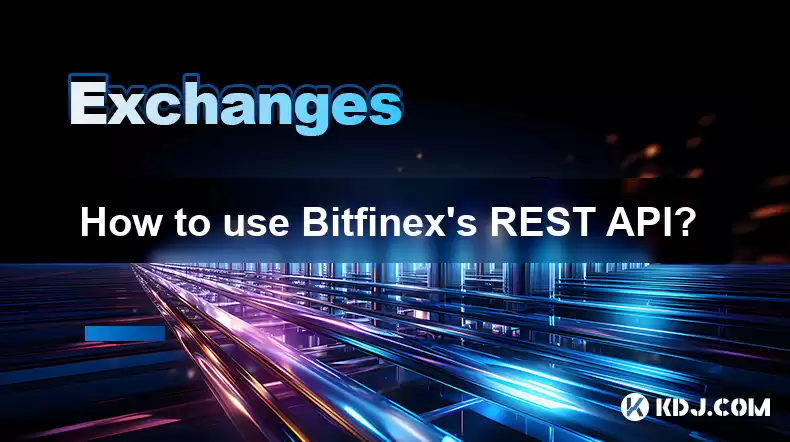-
 bitcoin
bitcoin $87959.907984 USD
1.34% -
 ethereum
ethereum $2920.497338 USD
3.04% -
 tether
tether $0.999775 USD
0.00% -
 xrp
xrp $2.237324 USD
8.12% -
 bnb
bnb $860.243768 USD
0.90% -
 solana
solana $138.089498 USD
5.43% -
 usd-coin
usd-coin $0.999807 USD
0.01% -
 tron
tron $0.272801 USD
-1.53% -
 dogecoin
dogecoin $0.150904 USD
2.96% -
 cardano
cardano $0.421635 USD
1.97% -
 hyperliquid
hyperliquid $32.152445 USD
2.23% -
 bitcoin-cash
bitcoin-cash $533.301069 USD
-1.94% -
 chainlink
chainlink $12.953417 USD
2.68% -
 unus-sed-leo
unus-sed-leo $9.535951 USD
0.73% -
 zcash
zcash $521.483386 USD
-2.87%
How to use Bitfinex's REST API?
Bitfinex's REST API lets you trade, get market data, and manage your account programmatically; this guide provides steps and examples for effective use.
Apr 14, 2025 at 03:35 am

Using Bitfinex's REST API allows you to interact programmatically with the exchange, enabling you to perform tasks such as trading, retrieving market data, and managing your account. This guide will walk you through the essential steps and provide detailed instructions on how to use Bitfinex's REST API effectively.
Getting Started with Bitfinex's REST API
Before you can start using Bitfinex's REST API, you need to set up an API key. To do this, follow these steps:
- Log in to your Bitfinex account.
- Navigate to the 'Account' section and select 'API'.
- Click on 'New Key' to generate a new API key.
- Choose the permissions you want to grant to the key, such as trading, withdrawals, or read-only access.
- Confirm the creation of the key and securely store the API key and secret.
Once you have your API key and secret, you can start making requests to the Bitfinex REST API. The API uses HTTPS and supports JSON for data exchange.
Authentication and Security
Authentication is crucial for securing your API interactions. Bitfinex uses a combination of your API key and a signature generated using your API secret. Here's how to authenticate your requests:
- Generate a nonce: A unique number that ensures each request is unique. This can be a timestamp or an incrementing integer.
- Create a payload: Combine the API path, nonce, and any additional parameters into a JSON object.
- Generate the signature: Use the HMAC-SHA384 algorithm with your API secret to sign the payload.
- Include the headers: Add the API key, payload, and signature to your request headers.
Here is an example of how to create the necessary headers in Python:
import timeimport jsonimport hmacimport hashlib
api_key = 'your_api_key'api_secret = 'your_api_secret'.encode()
Generate nonce
nonce = str(int(time.time() * 1000))
Create payload
payload = {
'request': '/v1/balance',
'nonce': nonce
}
Convert payload to JSON and encode
payload_json = json.dumps(payload).encode()
Generate signature
signature = hmac.new(api_secret, payload_json, hashlib.sha384).hexdigest()
Prepare headers
headers = {
'X-BFX-APIKEY': api_key,
'X-BFX-PAYLOAD': payload_json.decode(),
'X-BFX-SIGNATURE': signature
}
Making API Requests
With authentication in place, you can now make requests to Bitfinex's REST API. Here are some common endpoints and how to use them:
- Retrieve Account Balances: Use the
/v1/balancesendpoint to check your account balances.
import requests
url = 'https://api.bitfinex.com/v1/balances'response = requests.get(url, headers=headers)print(response.json())
- Place an Order: Use the
/v1/order/newendpoint to place a new order. You need to specify the symbol, amount, price, and order type.
payload = {
'request': '/v1/order/new',
'nonce': nonce,
'symbol': 'btcusd',
'amount': '0.01',
'price': '10000',
'exchange': 'bitfinex',
'type': 'exchange limit',
'side': 'buy'
}
payload_json = json.dumps(payload).encode()signature = hmac.new(api_secret, payload_json, hashlib.sha384).hexdigest()
headers = {
'X-BFX-APIKEY': api_key,
'X-BFX-PAYLOAD': payload_json.decode(),
'X-BFX-SIGNATURE': signature
}
url = 'https://api.bitfinex.com/v1/order/new'response = requests.post(url, headers=headers)print(response.json())
- Retrieve Market Data: Use the
/v1/pubtickerendpoint to get the current ticker for a specific trading pair.
url = 'https://api.bitfinex.com/v1/pubticker/btcusd'response = requests.get(url)print(response.json())Handling Errors and Responses
When using the Bitfinex REST API, it's important to handle errors and interpret responses correctly. Here are some tips:
- Check the HTTP status code: A 200 status code indicates a successful request, while other codes indicate errors.
- Parse the response JSON: The response will contain a JSON object with the requested data or error messages.
- Common error codes: Familiarize yourself with common error codes like 400 (Bad Request), 401 (Unauthorized), and 500 (Internal Server Error).
Here's an example of how to handle errors in Python:
import requests
url = 'https://api.bitfinex.com/v1/balances'response = requests.get(url, headers=headers)
if response.status_code == 200:
print('Request successful:', response.json())
else:
print('Error:', response.status_code, response.text)
Using WebSockets for Real-Time Data
While the REST API is suitable for many tasks, using WebSockets can provide real-time data updates. To connect to Bitfinex's WebSocket API, follow these steps:
- Establish a WebSocket connection: Use a WebSocket library like
websocket-client in Python.
import websocket
ws = websocket.WebSocket()ws.connect('wss://api-pub.bitfinex.com/ws/2')
- Subscribe to channels: Send a JSON message to subscribe to specific channels, such as ticker or order book updates.
subscribe_msg = {
'event': 'subscribe',
'channel': 'ticker',
'symbol': 'tBTCUSD'
}
ws.send(json.dumps(subscribe_msg))
- Process incoming messages: Parse the incoming JSON messages to handle real-time data.
result = ws.recv()print(result)Managing API Rate Limits
Bitfinex imposes rate limits on API requests to prevent abuse. To manage these limits effectively:
- Understand the limits: Bitfinex has different rate limits for authenticated and unauthenticated requests. Authenticated requests are typically limited to 90 requests per minute.
- Implement rate limiting in your code: Use libraries like
ratelimitin Python to ensure you stay within the limits.
from ratelimit import limits, sleep_and_retry
@sleep_and_retry@limits(calls=90, period=60)def call_api():
# Make your API call here
pass
Use the function
call_api()
Frequently Asked Questions
Q: Can I use Bitfinex's REST API to automate trading strategies?A: Yes, you can use the REST API to automate trading strategies by programmatically placing orders, checking balances, and retrieving market data. Ensure you implement proper error handling and rate limiting to maintain a stable trading environment.
Q: Is it possible to withdraw funds using the Bitfinex REST API?A: Yes, you can withdraw funds using the /v1/withdraw endpoint. You need to specify the withdrawal method, amount, and address. Make sure you have the necessary permissions on your API key to perform withdrawals.
A: Bitfinex offers a testnet environment where you can test your API requests without affecting your live account. You can sign up for a testnet account and use the testnet API endpoints to simulate trading and other operations.
Q: What should I do if I encounter an authentication error?A: If you encounter an authentication error, double-check your API key, secret, and the signature generation process. Ensure the nonce is unique for each request and that the payload is correctly formatted. If issues persist, consider regenerating your API key and secret.
Disclaimer:info@kdj.com
The information provided is not trading advice. kdj.com does not assume any responsibility for any investments made based on the information provided in this article. Cryptocurrencies are highly volatile and it is highly recommended that you invest with caution after thorough research!
If you believe that the content used on this website infringes your copyright, please contact us immediately (info@kdj.com) and we will delete it promptly.
- Cardano Price, ADA Pullback, and the Rise of Utility Networks: What's Next?
- 2025-12-07 05:45:01
- LILSHIB Who? Apeing & the Meme Coin Referral Rewards Revolution
- 2025-12-07 05:40:01
- Coinbase's Crypto Comeback Call: Is a December Recovery on the Horizon?
- 2025-12-07 20:05:01
- Bitcoin Price Wobbles: Crypto Market Eyes Recovery, Phong Lee Weighs In
- 2025-12-07 05:25:01
- Coins, Crypto, and Presales: What's Hot in the NYC Crypto Scene?
- 2025-12-07 18:25:01
- Altcoins on the Ropes: Declines and the Great Repricing of '25
- 2025-12-07 05:50:01
Related knowledge

How to convert small balances ("dust") to another coin on Bybit?
Dec 07,2025 at 08:59pm
Understanding Dust Conversion on Bybit1. Dust refers to tiny, non-withdrawable balances of cryptocurrencies left in a user’s spot wallet after partial...

Why is the Bybit app not working or showing a connection error?
Dec 07,2025 at 06:00pm
Troubleshooting Network Configuration Issues1. The Bybit app relies heavily on stable internet connectivity to synchronize real-time market data and e...

How does the profit-sharing system work in Bybit Copy Trading?
Dec 08,2025 at 03:19am
Profit Distribution Mechanism1. When a follower subscribes to a master trader on Bybit Copy Trading, their position size is automatically scaled based...

What is Dual Asset Mining on Bybit and what are the hidden risks?
Dec 08,2025 at 04:40pm
Dual Asset Mining Overview1. Dual Asset Mining is a structured financial product offered by Bybit that allows users to deposit two cryptocurrencies—ty...

How does Bybit P2P trading work and is it a safe way to buy crypto?
Dec 08,2025 at 05:00pm
Bybit P2P Trading Infrastructure1. Bybit P2P operates as a peer-to-peer marketplace where users directly trade cryptocurrencies with one another using...

Is Bybit safe to use, and are my funds insured against hacks?
Dec 08,2025 at 02:19am
Security Infrastructure of Bybit1. Bybit deploys multi-layered cold wallet storage for over 95% of user assets, isolating private keys from internet-c...

How to convert small balances ("dust") to another coin on Bybit?
Dec 07,2025 at 08:59pm
Understanding Dust Conversion on Bybit1. Dust refers to tiny, non-withdrawable balances of cryptocurrencies left in a user’s spot wallet after partial...

Why is the Bybit app not working or showing a connection error?
Dec 07,2025 at 06:00pm
Troubleshooting Network Configuration Issues1. The Bybit app relies heavily on stable internet connectivity to synchronize real-time market data and e...

How does the profit-sharing system work in Bybit Copy Trading?
Dec 08,2025 at 03:19am
Profit Distribution Mechanism1. When a follower subscribes to a master trader on Bybit Copy Trading, their position size is automatically scaled based...

What is Dual Asset Mining on Bybit and what are the hidden risks?
Dec 08,2025 at 04:40pm
Dual Asset Mining Overview1. Dual Asset Mining is a structured financial product offered by Bybit that allows users to deposit two cryptocurrencies—ty...

How does Bybit P2P trading work and is it a safe way to buy crypto?
Dec 08,2025 at 05:00pm
Bybit P2P Trading Infrastructure1. Bybit P2P operates as a peer-to-peer marketplace where users directly trade cryptocurrencies with one another using...

Is Bybit safe to use, and are my funds insured against hacks?
Dec 08,2025 at 02:19am
Security Infrastructure of Bybit1. Bybit deploys multi-layered cold wallet storage for over 95% of user assets, isolating private keys from internet-c...
See all articles










































































